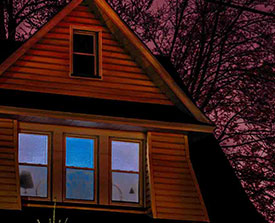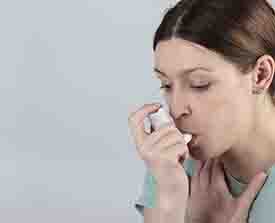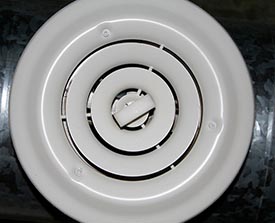
A Healthy Home instructor Joel Gregory has made a vocation of helping others solve complex problems. Prior to working for King County Housing Authority’s (KCHA) Weatherization Program (WX) for over two decades, he taught at a private school dedicated to educating at risk children and young adults. “During the summers I worked for a building contractor until past injuries started to slow me down,” he says. “After that I was trained as an energy auditor and pursued it for a couple of years until being hired by the KCHA WX program…where I was learning something new every day. I was able to assist families and elderly folks in saving energy and money so they could afford food and utilities. I liked teaching homeowners about their homes and how to make them more comfortable.”
Gregory made it a point to keep abreast of discoveries and advances in the home health industry. “One class that had a huge impact on my work and outlook was the locally developed Master Home Environmentalist Program,” he recalls. “I learned about toxins in the home, rodents, insects, spiders, and the benefits of a clean home on physical and mental health. I became a certified Lead Paint Risk Assessor and taught classes to contractors about how to work lead-safe. I took classes and have several certificates from the Building Performance Institute that cover a lot of building science.”
Going forward, Gregory found a passion for healthy home programs, and experienced great success in coordinating them through the King County Public Health Asthma Program. “Our office did the WX work for energy efficiency and Indoor Air Quality. Community Health Workers educated families about asthma and supported them in their efforts in changing behaviors towards a healthier home,” he says. “We had great success with these asthma interventions and permanently removed triggers from many homes.”
What does it mean to have a healthy home, particularly when considering the Whole-House Approach to energy efficiency? Gregory says it starts with taking a close look at how home components interact. “The systems in the home are the plumbing, ventilation, insulation, heating, cooling, and electrical. When we change one thing, other phenomena occur that we need to address. Not only are we looking at energy efficiency but we also want to leave the house with good indoor air quality.”
“For instance,” Gregory says, “When we enter a home that is using a lot of energy to heat because occupants feel a draft, we start looking for air leaks.” He points to the fireplace as a key culprit. “The first thing we do is look up the chimney flue with a flash light to see if the damper is open. If it is open, it will be pulling lots of air from the outside through cracks in the house creating a draft. We ask the owner if they had a fire recently and if they say ‘no’ we know this has been the primary ventilation for the house.”
According to Gregory, ventilation removes moisture and odors, but in this case, it also removes a great deal of heated air. “We close the damper or put a chimney top damper on the top of the chimney and problem solved.” Or so it would seem. The heat loss and drafts were curtailed because the fireplace removed moisture, but the homeowners soon found the windows and walls covered in condensation.
“The air is clammy meaning high humidity, so now we need to add some mechanical ventilation and wall insulation,” Gregory says. “In this example we have eliminated the ‘natural’ ventilation that was keeping the house dry and added mechanical ventilation and wall insulation. This will keep the house dry and warmed while eliminating condensation on wall surfaces.”
 Ventilation issues are but one example of common systemic concerns Gregory says most homeowners need direction in recognizing. “As far as health in the home, if asthma is present carpets pose a health risk, as do smoke from fire places, wood stoves and burning incense or scented candles.”
Ventilation issues are but one example of common systemic concerns Gregory says most homeowners need direction in recognizing. “As far as health in the home, if asthma is present carpets pose a health risk, as do smoke from fire places, wood stoves and burning incense or scented candles.”
Gregory says the first step in helping homeowners establish a healthy abode starts with identifying and then discussing the issues at hand. “As I inspect a home I explain what I am seeing and teach homeowners how to use the home to their advantage. I once walked into a home with condensation all over the front single pane window. It was morning and they had all bathed and had breakfast. I turned on a fan for the two hours I was doing my inspection to see what would become of the condensation. By the time I left most of the visible moisture was gone from the front window. They saw the effect of using a fan. They now have a tool to improve their indoor air quality.”
It leaves one wondering; do healthy home issues stem from a house’s age or its construction? Gregory says it can be a matter of both. “Building codes have changed over time as the science of buildings has become more rigorous. In addition, people became more aware of conservation after the energy crunch of the 70's. Insulation was not used much until the building codes changed in the 70's and 80's requiring more insulation. Fire codes now require much more sealing to block air movement within a building and stop the flow of hot air. This inhibits the warm air from leaving a home and slows the intake of fresh air to feed the fire.”
Students joining A Healthy Home will be encouraged to bring their own home issues to class for discussion. “I will be addressing Building Science so people can understand how structures behave,” Gregory says. “We'll also address energy efficiency, toxins in the home and talk about what a healthy home looks like. I do a lot of drawing and will do some demonstrations regarding pressures, ventilation strategies and more depending on student issues.”
At the conclusion of A Healthy Home, Gregory hopes students leave with a new understanding of their home environment, particularly the movement of air, moisture and a method for solving their problems. “I hope they start asking ‘Why?’ and gain a basic understanding of ‘wet goes to dry, high pressure goes to low pressure and heat goes to cold’. In addition they will have access to resources they can turn to for answers for their questions.”
Learn more about A Healthy Home.
Photo credit #2: Lily May_cc_2.0
Photo credit #3: Curt_cc_2.0